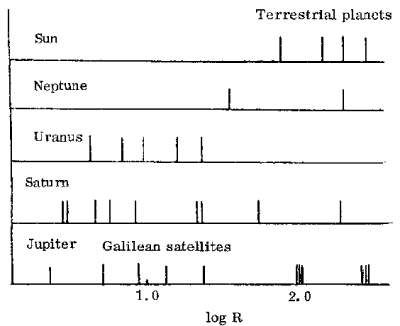 |
Science Frontiers ONLINE No. 42: Nov-Dec 1985 |
|
|
A Different Way Of Looking At The Solar System
The current scientific consensus has the sun and its planets forming during the same process of accretion/condensation. In this view, the inner terrestrial planets differ from the outer giant planets only because their volatile elements were driven off by the sun's heat. This scenario has many problems, as recorded in our catalog volume The Moon and the Planets.
G.H.A. Cole thinks that astronomers might have more success in explaining the origin of the solar system if they considered it a system of five large bodies of star stuff (light elements), each surrounded by its own retinue of high density satellites (the sun's four satellites would be the inner planets). In effect, then, we would have a quintuple star system in which only one member (the sun) collected enough star stuff to make it to incandescence. The four, large, outer planets would be merely failed stars.
The advantages of this change of perspective are threefold:
(1) All five central bodies are now compositionally similar as a class, (2) In each of the five systems, the angular momentum of the central body is greater than that of its satellites, whereas in the unitary solar system the angular momentum of the nine planets is much greater than that of the sun -- an embarrassing anomaly. (3) A final "bonus" appears when the distances of the satellites in the five systems are plotted, as indicated, and compared. The arrangement of the four terrestrial planets (the "solar satellites") closely resembles the distribution of Jupiter's four Galilean satellites.
There are loose ends, to be sure, like Pluto and Saturn's rings, but the idea seems worth studying further.
(Cole, G.H.A.; "Dynamical Form of the Solar System," Observatory, 105:96, 1985.)
Comment. The arrangement of satellites in the figure may have no physical significance, but if you like Bode's Law you should appreciate the situation.
Reference. For more information on the book The Moon and the Planets, visit: here.
 | Distribution of orbital radii (r) of central body satellites, where R is measured in terms of central body radii. Cole terms the similarities 'remarkable'. |